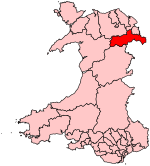Battle of Crogen

The Battle of Crogen is an engagement said to have taken place in Wales during Henry II of England's summer 1165 campaign against an alliance of Welsh kingdoms led by King of Gwynedd, Owain Gwynedd. Later Welsh chronicles recorded that a detachment of Welsh troops inflicted a number of casualties on the Anglo-Norman army in the Ceiriog Valley; Henry subsequently abandoned the campaign after an attempt to cross the Berwyn Mountains was thwarted by severe weather. It is unclear whether events in the Ceiriog Valley represented a pitched battle, a series of smaller engagements or a minor skirmish: all three have been argued, as well as the possibility no fighting took place during the 1165 campaign. It has been suggested that the idea of a "battle" should be considered as folklore rather than as a genuine historical event. There are few contemporary accounts: 19th century and later accounts of the "battle" rely heavily on David Powel's 1584 Historie of Cambria, an unreliable historical source.
Excerpt from the Wikipedia article Battle of Crogen (License: CC BY-SA 3.0, Authors, Images).Battle of Crogen
Geographical coordinates (GPS) Address Nearby Places Show on map
Geographical coordinates (GPS)
| Latitude | Longitude |
|---|---|
| N 52.939 ° | E -3.104 ° |
Address
SY10 7NE , Glyntraian
Wales, United Kingdom
Open on Google Maps










